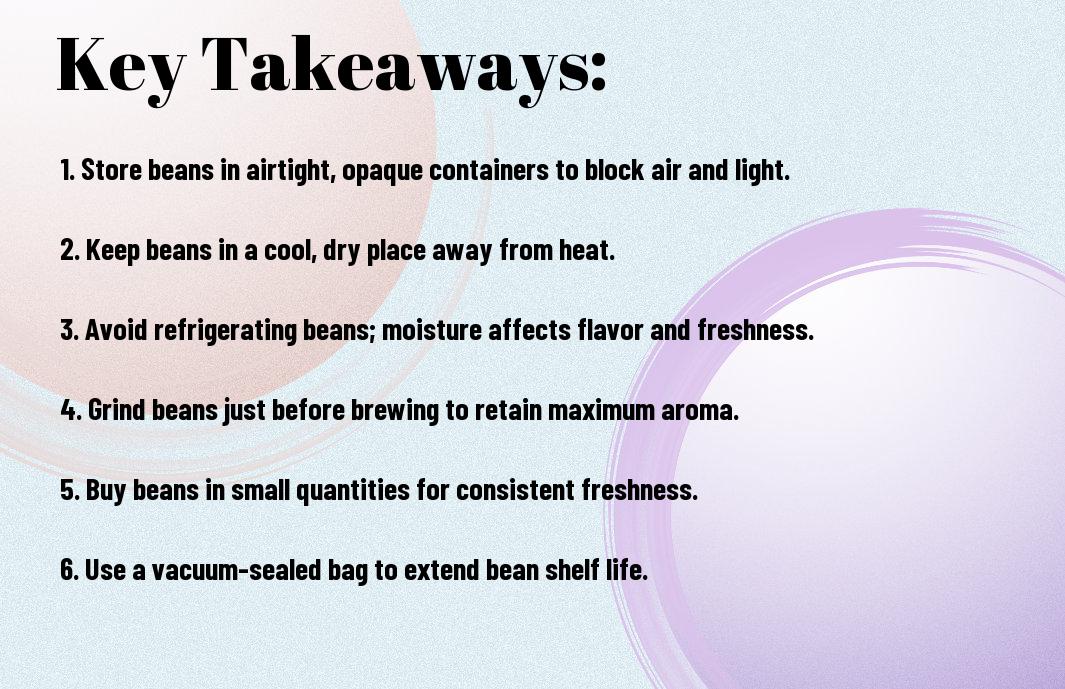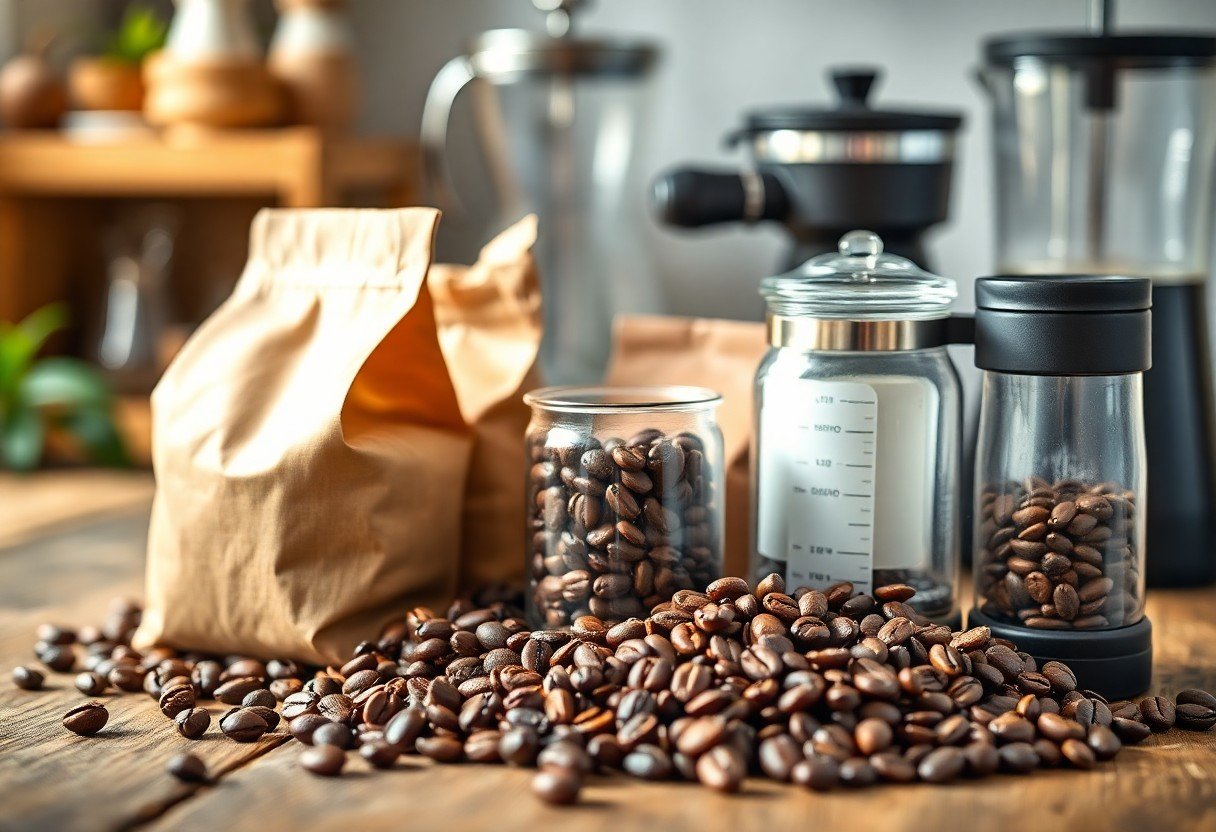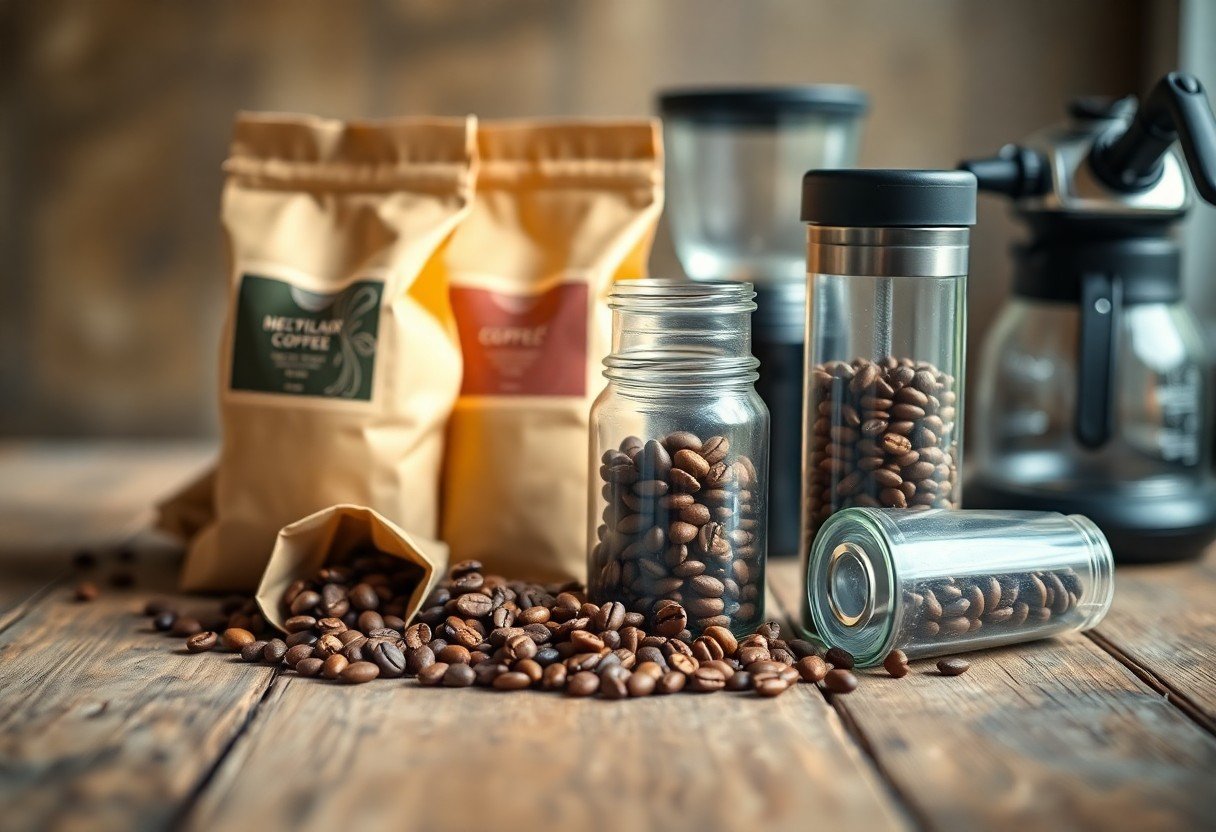Most coffee lovers understand the importance of flavor and aroma in their daily brew, but few recognize that freshness is key to achieving the ultimate coffee experience. To truly enjoy your coffee, you need to take steps to preserve the freshness of your beans. In this post, you’ll learn expert tips and best practices to ensure that your coffee beans stay vibrant and full of flavor, allowing you to savor each cup like the connoisseur you aspire to be.


The Deterioration Dilemma: Understanding What Affects Coffee Freshness
Coffee beans experience numerous factors that contribute to their deterioration, significantly impacting their freshness and flavor. Exposure to light, oxygen, moisture, and high temperatures can lead to stale, flat-tasting coffee. Unless you implement proper storage techniques, like those outlined in How to Store Your Coffee Beans for Maximum Freshness, your beans may lose their aromatic oils and complex flavors in no time. Understanding these influences is key to enjoying coffee at its best.
The Importance of Freshness in Flavor
The freshness of coffee directly influences its flavor profile. Fresh beans release their oils, which carry imperative aromatic compounds that create a rich and vibrant experience in each cup. As time passes, these oils oxidize, quickly diminishing the depth of flavor. A freshly brewed cup of coffee brings out the unique tasting notes inherent in your beans, allowing you to fully appreciate the craft of coffee production.
Factors Contributing to Coffee Bean Degradation
Several factors contribute to the degradation of your coffee beans, which can lead to disappointing cups and loss of flavor. While oxidation might be one of the most significant forces at play, other players like exposure to humidity and light can wreak havoc on your coffee stash. Additionally, the roasting date plays a huge role; older roasted beans simply can’t match the flavorful brightness of freshly roasted ones. Ensuring you minimize these factors will help maintain your beans’ optimal condition.
- Moisture can brew mold or mildew, ruining your beans.
- Flavor can be stripped away by oxidation from air exposure.
- Exposure to light can lead to the breakdown of imperative oils.
- Heat can cause a loss of aroma and flavor intensity.
- Perceiving how these elements interact ensures your beans stay at their best.
Each of these factors can progressively diminish your coffee’s quality. For example, when coffee beans are stored in a humid environment, they absorb moisture, which can lead to mold. Similarly, exposing them to air increases oxidation rates, leading to stale flavors. Temperature is another concern; beans stored near heat sources undergo chemical changes that negatively affect taste. Perceiving these factors and adjusting your storage methods accordingly will significantly enhance how you enjoy your coffee.
- Consider achieving proper air-tight storage solutions to combat oxidation.
- Avoid storing coffee near windows where light can diminish freshness.
- Using opaque containers can block harmful light exposure.
- Keeping beans in a cool, temperature-stable place is ideal.
- Perceiving all these elements together creates an optimal environment for your precious beans.
Air Tight Solutions: Container Choices for Longevity
Your choice of container can significantly impact the freshness of your coffee beans. Opting for airtight solutions not only keeps out oxygen but also shields against moisture, light, and odors—factors that accelerate deterioration. Glass jars with sealed lids, stainless steel containers, and vacuum-sealed bags can all serve this purpose effectively. Each option has its individual qualities that can enhance or hinder the longevity of your coffee, so understanding these differences is key to maintaining that just-roasted taste.
The Pros and Cons of Different Coffee Storage Materials
Pros and Cons of Coffee Storage Materials
| Material | Pros | Cons |
| Glass | Non-porous and does not absorb odors. | Can be fragile and may break easily. |
| Stainless Steel | Durable, opaque, and resistant to rust and corrosion. | Can retain heat, potentially impacting flavor. |
| Plastic | Lightweight and portable. | Pores can absorb smells, and it may not be fully airtight. |
| Vacuum-Sealed Bags | Minimizes air exposure and extends shelf life. | Once opened, they need quick consumption. |
| Ceramic | Stylish and often comes with airtight seals. | Can be heavy and may chip or crack. |
| Wood | Natural aesthetics and can be absorbent. | Not airtight; can lead to moisture retention issues. |
| Textile Bags | Breathable; ideal for short-term storage. | Not airtight; beans can lose freshness quickly. |
Ideal Container Characteristics for Optimal Preservation
Choosing the right characteristics in your coffee storage container can make all the difference in preserving flavor and aroma. Look for airtight seals that lock out moisture and air while using opaque materials to block harmful light. The ideal container should also resist odors and be made of non-porous material to prevent any interaction with the beans. Additionally, ease of access can impact how often you open the container, so a design that allows for minimal exposure is beneficial. Investing in these features will ensure you maintain the exquisite profile of your coffee for longer.
Temperature and Humidity: The Silent Killers of Coffee Quality
The environment in which you store your coffee beans plays a significant role in maintaining their quality. High temperatures and fluctuating humidity levels can degenerate the beans, causing them to lose flavor and aroma quickly. You should aim to keep the storage area at a consistent temperature between 60-70°F (15-21°C) and humidity levels below 50%. Doing so helps maintain the freshness you desire.
| Temperature | 60-70°F (15-21°C) |
| Humidity | Below 50% |
Creating the Perfect Environment for Coffee Storage
Your coffee beans thrive in specific conditions that protect them from outside elements. Choosing an airtight container made of opaque material will shield your beans from light and air exposure. Storing them in a cool, dark place, such as a pantry or a dedicated coffee drawer, will also help you create a stable environment free from temperature swings and moisture, which can lead to an unpleasant taste.
Specific Climate Considerations for Bean Preservation
If you live in a humid climate, protecting your coffee beans from excess moisture becomes paramount. A good practice involves utilizing a desiccant pack within your storage container to absorb any humidity. Conversely, in arid situations, the risk of beans drying out increases, often leading to unpleasant flavors. A simple solution is to keep your beans in a slightly humidified environment, away from direct sunlight, to retain that sought-after freshness.
For those dwelling in coastal areas, salt air can also affect the quality of your coffee. Selecting a storage location far from windows or doors can prevent both humidity from breaking through and the salty air from seeping in. Urban environments, often bustling with pollution, require an even more vigilant approach—opt for a vacuum-sealed bag to further shield against contaminants. Ultimately, recognizing specific climate challenges allows you to tailor your coffee preservation strategy effectively.

The Grind Factor: How Preparation Affects Freshness
Paying attention to the grind of your coffee beans can significantly impact their freshness and overall flavor. Once coffee beans are ground, they release volatile oils and aroma compounds, which begin to dissipate rapidly. The size of the grind also affects the extraction process during brewing; a finer grind may extract stronger flavors, while a coarser grind leads to milder notes. Your choice not only influences the taste of your coffee but also its longevity, making grinding a vital step in preserving the quality of your brew.
Grinding Just Before Brewing: Why It’s Essential
Grinding your coffee beans immediately before brewing allows you to capture the full spectrum of flavors and aromas that are lost once the beans are opened. Freshly ground coffee produces a richer taste and a more aromatic experience due to the rapid release of compounds. The moment beans are ground, the oxidation process accelerates, leading to a decline in freshness. By taking the time to grind just before you brew, you’re ensuring that each cup maximizes its potential, giving you a truly authentic coffee experience.
Whole Beans vs. Pre-Ground: Making the Right Choice
Whole beans offer the advantage of maintaining freshness longer than pre-ground coffee due to the sealed environment that protects them from exposure, oxidation, and moisture. Pre-ground coffee, while convenient, loses its flavor quickly and often lacks the complexity that freshly ground beans provide. Choosing whole beans gives you control over the grind size, allowing you to tailor your brewing method and extract the best flavors from your coffee.
Opting for whole beans rather than pre-ground coffee can be a game changer in your daily brew. Whole beans have a shelf life of several weeks when stored properly, while pre-ground coffee can start losing its vibrancy within just days of being ground. By investing in a grinder, you can preserve the imperative oils and delicate flavors that would otherwise be compromised in pre-ground options, ensuring every cup you brew is a reflection of your devotion to quality coffee. Whether you prefer a fine grind for espresso or a coarse grind for French press, the control and freshness from whole beans are unmatched.
The Ritual of Freshness: Best Practices for Coffee Enthusiasts
In the world of coffee connoisseurs, cultivating freshness is more than just a habit—it’s a daily ritual. By weaving specific practices into your coffee routine, you can maintain the integrity of your beans and unleash their full flavor potential. Engage in mindful consumption, measuring your grind size precisely and selecting methods that prioritize quality, like a pour-over or French press, all while ensuring your tools are clean and well-maintained for each brew. A commitment to these practices will transform the simple act of brewing into a elevated coffee experience.
Daily Habits to Maintain Bean Quality
Storing your coffee beans in an airtight container in a cool, dark place can preserve their flavor and aroma for weeks. Avoid leaving them exposed to light, air, or moisture, as these elements can expedite staleness. Regularly check your stock, buy small batches to ensure freshness, and consider grinding your beans right before brewing. Implementing these daily habits elevates your coffee-making process, keeping each cup freshly aromatic and bursting with flavor.
Innovative Techniques Inspired by Experts
Professional baristas utilize innovative techniques to maintain coffee bean freshness that you might find inspiring. For instance, some recommend using nitrogen-flushed bags, which displace oxygen and extend shelf life by up to 50%. Others adopt the practice of freezing unused beans to halt oxidation. Additionally, investing in a coffee fridge designed for optimized storage can help maintain stable temperatures for your beans, replicating the favorable conditions of specialty coffee shops.
Many coffee aficionados have embraced these expert techniques to achieve café-quality brews at home. For instance, nitrogen-flushed bags are increasingly popular among roasters because they allow beans to be packed without the damaging effects of exposure to air. On the freezing front, it’s recommended to divide your batch into small portions, so you only expose the amount you’ll use within a week to room temperature. This strategic approach to freshness showcases that small adjustments in how you handle your coffee can translate to highly satisfying, flavorful cups at home.
To wrap up
Conclusively, to preserve the freshness of your coffee beans like a connoisseur, you should store them in an airtight container away from light, heat, and moisture. Opt for whole beans over pre-ground for maximum flavor, and grind only the amount you need right before brewing. Additionally, keeping your coffee in a cool, dark place will further enhance its longevity. By following these practices, you can ensure your coffee retains its rich aroma and taste, elevating your daily brew to a delightful experience.
Q: What are the best storage conditions for coffee beans to maintain their freshness?
A: To preserve the freshness of your coffee beans, store them in an airtight container away from light, heat, and moisture. Ideally, use a dark glass jar or a bag with a one-way valve that protects the beans from oxygen exposure. The storage area should be cool, preferably around 60-70°F (15-21°C), to inhibit any degradation in flavor.
Q: How does grinding affect the freshness of my coffee beans?
A: Grinding your coffee beans increases the surface area exposed to air, which accelerates the staling process. To maintain freshness, it’s best to grind your beans just before brewing. If you prefer to grind in bulk, consider using a burr grinder for a uniform grind size and storing the ground coffee in an airtight container to limit exposure to air and maintain flavor.
Q: Is it better to buy whole beans or pre-ground coffee for freshness?
A: Whole beans are far superior for freshness compared to pre-ground coffee. Whole beans retain their natural oils and flavors longer because they have a smaller surface area exposed to air. When possible, purchase whole beans in smaller quantities and grind them as needed to ensure you’re enjoying the full flavor profile of your coffee.

